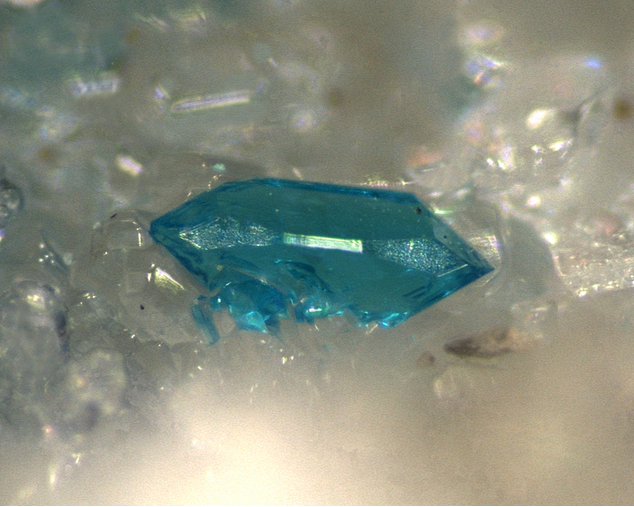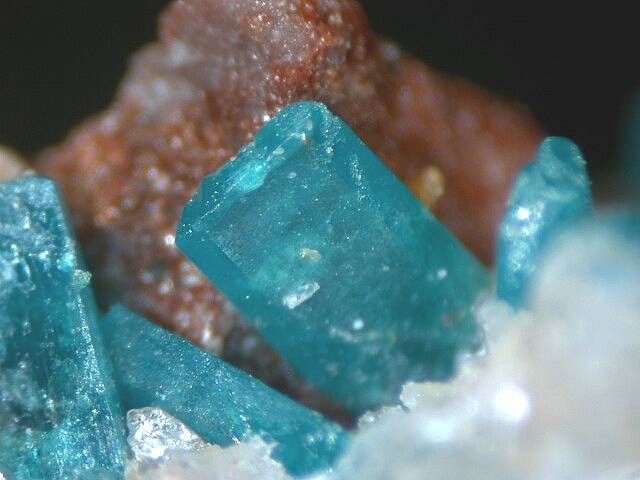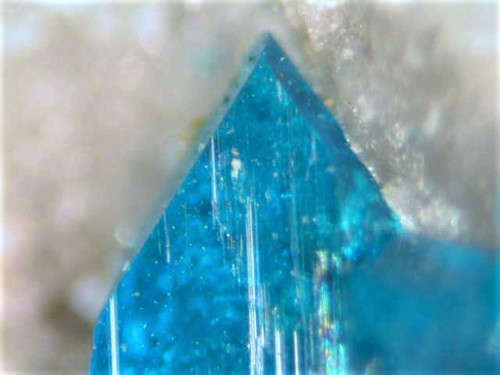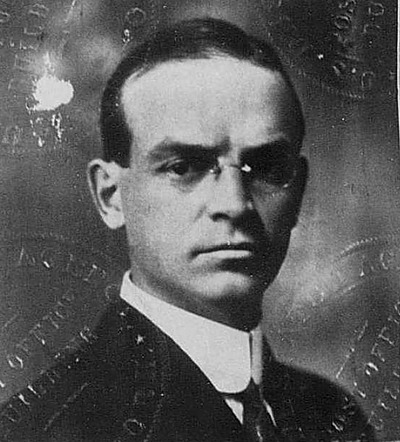Salesite
A valid IMA mineral species - grandfathered
This page is currently not sponsored. Click here to sponsor this page.
About Salesite
Formula:
Cu(IO3)(OH)
Colour:
Bluish-green; bluish green in transmitted light
Lustre:
Vitreous
Hardness:
3
Specific Gravity:
4.72 - 4.82
Crystal System:
Orthorhombic
Name:
Named after Reno Haber Sales (10 September 1876, Storm Lake, Iowa, USA - 9 May 1969, Bozeman, Montana, USA), chief geologist, Anaconda Copper Company, Chile. He was awarded the Penrose Award of the Society of Economic Geologists in 1939.
Attempts at synthesis gave an orthorhombic dimorph, differing in cleavage and optical properties with respect to salesite (Palache and Jarrell, 1939).
Unique Identifiers
Mindat ID:
3509
Long-form identifier:
mindat:1:1:3509:1
GUID
(UUID V4):
(UUID V4):
d1869cb4-726f-4a69-931c-e2c9b28bfcfe
IMA Classification of Salesite
Approved, 'Grandfathered' (first described prior to 1959)
First published:
1939
Classification of Salesite
4.KB.05
4 : OXIDES (Hydroxides, V[5,6] vanadates, arsenites, antimonites, bismuthites, sulfites, selenites, tellurites, iodates)
K : Iodates: Trigonal [IO3] pyramids (mostly).
B : Iodates with additional anions, without H2O
4 : OXIDES (Hydroxides, V[5,6] vanadates, arsenites, antimonites, bismuthites, sulfites, selenites, tellurites, iodates)
K : Iodates: Trigonal [IO3] pyramids (mostly).
B : Iodates with additional anions, without H2O
Dana 7th ed.:
22.1.1.1
22.1.1.1
22 : IODATES CONTAINING HYDROXYL OR HALOGEN
1 : Miscellaneous
22 : IODATES CONTAINING HYDROXYL OR HALOGEN
1 : Miscellaneous
29.1
29 : Iodates
29 : Iodates
Mineral Symbols
As of 2021 there are now IMA–CNMNC approved mineral symbols (abbreviations) for each mineral species, useful for tables and diagrams.
| Symbol | Source | Reference |
|---|---|---|
| Sls | IMA–CNMNC | Warr, L.N. (2021). IMA–CNMNC approved mineral symbols. Mineralogical Magazine, 85(3), 291-320. doi:10.1180/mgm.2021.43 |
Physical Properties of Salesite
Vitreous
Transparency:
Transparent
Colour:
Bluish-green; bluish green in transmitted light
Hardness:
3 on Mohs scale
Cleavage:
Perfect
on {101}
on {101}
Density:
4.72 - 4.82 g/cm3 (Measured) 4.888 g/cm3 (Calculated)
Optical Data of Salesite
Type:
Biaxial (-)
RI values:
nα = 1.786 nβ = 2.070 nγ = 2.075
2V:
Calculated: 12°
Max Birefringence:
δ = 0.289

Image shows birefringence interference colour range (at 30µm thickness)
and does not take into account mineral colouration.
and does not take into account mineral colouration.
Surface Relief:
Very High
Dispersion:
r > v, extreme.
Optical Extinction:
X = c; Y = b; Z = a.
Pleochroism:
Visible
Comments:
X = Colourless
Y = Light bluish green
Z = Bluish green
Y = Light bluish green
Z = Bluish green
Chemistry of Salesite
Mindat Formula:
Cu(IO3)(OH)
Elements listed:
Crystallography of Salesite
Crystal System:
Orthorhombic
Class (H-M):
mmm (2/m 2/m 2/m) - Dipyramidal
Space Group:
Pnma
Cell Parameters:
a = 10.794 Å, b = 6.708 Å, c = 4.781 Å
Ratio:
a:b:c = 1.609 : 1 : 0.713
Unit Cell V:
346.17 ų (Calculated from Unit Cell)
Z:
4
Morphology:
Crystals stout prismatic [001] with pyramidal terminations. Forms include {001}, {010}, {130}, {110}, {023}, {011}, {111}.
Crystal Structure
Load
Unit Cell | Unit Cell Packed
2x2x2 | 3x3x3 | 4x4x4
Unit Cell | Unit Cell Packed
2x2x2 | 3x3x3 | 4x4x4
Show
Big Balls | Small Balls | Just Balls | Spacefill
Polyhedra Off | Si Polyhedra | All Polyhedra
Remove metal-metal sticks
Big Balls | Small Balls | Just Balls | Spacefill
Polyhedra Off | Si Polyhedra | All Polyhedra
Remove metal-metal sticks
Display Options
Black Background | White Background
Perspective On | Perspective Off
2D | Stereo | Red-Blue | Red-Cyan
Black Background | White Background
Perspective On | Perspective Off
2D | Stereo | Red-Blue | Red-Cyan
View
CIF File Best | x | y | z | a | b | c
CIF File Best | x | y | z | a | b | c
Rotation
Stop | Start
Stop | Start
Labels
Console Off | On | Grey | Yellow
Console Off | On | Grey | Yellow
Data courtesy of the American Mineralogist Crystal Structure Database. Click on an AMCSD ID to view structure
| ID | Species | Reference | Link | Year | Locality | Pressure (GPa) | Temp (K) |
|---|---|---|---|---|---|---|---|
| 0000612 | Salesite | Ghose S, Wan C (1978) Salesite, CuIO3(OH), and Cu(IO3)2*2H2O: A comparison of the crystal structures and their magnetic behavior American Mineralogist 63 172-179 |  | 1978 | synthetic | 0 | 293 |
CIF Raw Data - click here to close
X-Ray Powder Diffraction
Image Loading
Radiation - Copper Kα
Data courtesy of RRUFF project at University of Arizona, used with permission.
Powder Diffraction Data:
| d-spacing | Intensity |
|---|---|
| 4.37 Å | (100) |
| 3.66 Å | (65) |
| 2.394 Å | (60) |
| 1.788 Å | (55) |
| 2.698 Å | (50) |
| 5.38 Å | (40) |
| 2.636 Å | (30) |
Comments:
Chuquicamata, Chile, ICDD 22-236.
Geological Environment
Paragenetic Mode(s):
| Paragenetic Mode | Earliest Age (Ga) |
|---|---|
| Stage 7: Great Oxidation Event | <2.4 |
| 47a : [Near-surface hydration of prior minerals] | |
| 47g : [Halogen-bearing surface weathering minerals] | |
| 47h : [Near-surface oxidized, dehydrated minerals] |
Type Occurrence of Salesite
Co-Type Localities:
General Appearance of Type Material:
Stout, prismatic crystals with a pyramidal termination.
Place of Conservation of Type Material:
Harvard University, Cambridge, Massachusetts, USA, number 95027.
Geological Setting of Type Material:
Oxidized zone of copper deposit in an arid climate.
Associated Minerals at Type Locality:
Reference:
Palache, C., Jarrell, O.W. (1939) Salesite, a new mineral from Chuquicamata, Chile. American Mineralogist: 24(6): 388-392.
Other Language Names for Salesite
Common Associates
Associated Minerals Based on Photo Data:
Related Minerals - Strunz-mindat Grouping
| 4.KB. | Bluebellite | Cu6[(I5+O3)(OH)3](OH)7Cl |
| 4.KB. | Pohlite | Pb7(IO3)(OH)4Cl9 |
| 4.KB.10 | Schwartzembergite | Pb5H2(IO2)O4Cl3 |
| 4.KB.15 | Seeligerite | Pb3(IO3)OCl3 |
Fluorescence of Salesite
None
Other Information
Notes:
Insoluble in water. Readily soluble in HNO3.
In a closed tube, when first heated, it snaps into small splinters and almost at once gives copious purple fumes of iodine that crystallize on the wall of the tube. A small amount of water is also given off.
In forceps, heated gradually, it darkens and yields a clear green flame of copper iodide without fusing. The residue left after heating on charcoal is readily reduced to metallic copper.
In a closed tube, when first heated, it snaps into small splinters and almost at once gives copious purple fumes of iodine that crystallize on the wall of the tube. A small amount of water is also given off.
In forceps, heated gradually, it darkens and yields a clear green flame of copper iodide without fusing. The residue left after heating on charcoal is readily reduced to metallic copper.
Health Risks:
No information on health risks for this material has been entered into the database. You should always treat mineral specimens with care.
Internet Links for Salesite
mindat.org URL:
https://www.mindat.org/min-3509.html
Please feel free to link to this page.
Please feel free to link to this page.
Search Engines:
External Links:
Mineral Dealers:
References for Salesite
Localities for Salesite
Locality List
 - This locality has map coordinates listed.
- This locality has map coordinates listed.
 - This locality has estimated coordinates.
ⓘ - Click for references and further information on this occurrence.
? - Indicates mineral may be doubtful at this locality.
- This locality has estimated coordinates.
ⓘ - Click for references and further information on this occurrence.
? - Indicates mineral may be doubtful at this locality.
 - Good crystals or important locality for species.
- Good crystals or important locality for species.
 - World class for species or very significant.
(TL) - Type Locality for a valid mineral species.
(FRL) - First Recorded Locality for everything else (eg varieties).
- World class for species or very significant.
(TL) - Type Locality for a valid mineral species.
(FRL) - First Recorded Locality for everything else (eg varieties).
All localities listed without proper references should be considered as questionable.
Brazil | |
| Thomas et al. (2023) |
Chile (TL) | |
| Palache et al. (1939) |
| O'Donoghue +2 other references |
Quick NavTopAbout SalesiteUnique IdentifiersIMA Classification Classification Mineral SymbolsPhysical Properties Optical Data Chemistry Crystallography Crystal StructureX-Ray Powder DiffractionGeological EnvironmentType Occurrence Other LanguagesCommon AssociatesStrunz-MindatFluorescence Other InformationInternet Links References Localities Locality List






 symbol to view information about a locality.
The
symbol to view information about a locality.
The 



Chuquicamata Mine, Chuquicamata District, Calama, El Loa Province, Antofagasta, Chile